| Red-footed Booby
Sula sula Boba Blanca,
|
|
|
Photo: B. Hallett
|
| Red-footed Booby
Sula sula Boba Blanca,
|
|
|
Photo: B. Hallett
|
|
IDENTIFICATION: A large white seabird with dark trailing edges to the wings, and bright red feet. Some individuals have a brown body with a white tail. Length: 69-79 cm.; weight: 850-1,100 g., the females being larger than males. VOICE: Away from breeding grounds, this species is usually silent, but squawks when frigatebirds attempt to steal its food. HABITAT: Feeds for long periods at sea in deep tropical oceans. HABITS: Flies great distances in search of food, and will dive from a height of 4-8 meters as it hunts squid and fish (especially flying fish). It sometimes catches flying fish in mid-air. It often feeds with other seabirds over schools of tuna and other predatory fish, as they force smaller prey to the surface. The central claw on each foot is elongated and has ridges that act as a comb for preening. At colonial nesting islands, the male brings twigs to the female who builds the nest in a bush or small tree. She lays one white egg. Both sexes incubate the egg for shifts that may last more than a day. After 45-46 days, the egg hatches. Both parents feed the chick progressively larger fish and squid, and at least one adult guards the chick most of the time until it is 6-8 weeks old. The chick starts to flap its wings after four weeks and can fly at about three months. But the parents continue to feed the chick near the nest for several months after the chick can fly. This species does not start breeding until 3-4 years of age. STATUS AND CONSERVATION: A local, not commonly-seen seabird partly because of its more pelagic foraging habits. Large colonies, however, are found at Mona and Monito, as well as smaller numbers near Culebra and the Virgin Islands. Introduced predators such as dogs, cats, and pigs are a problem on many nesting islands, as well as shootings. Introduced monkeys decimated the colony on Desecheo Island. The West Indian breeding population is estimated at 8,200-10,000 pairs. RANGE: The Red-footed Booby occurs throughout the world’s tropical oceans. The biggest colony in the northern Caribbean is on Little Cayman Island. TAXONOMY: PELECANIFORMES; SULIDAE |
|
 |
|
|
Photo: B. Hallett
|
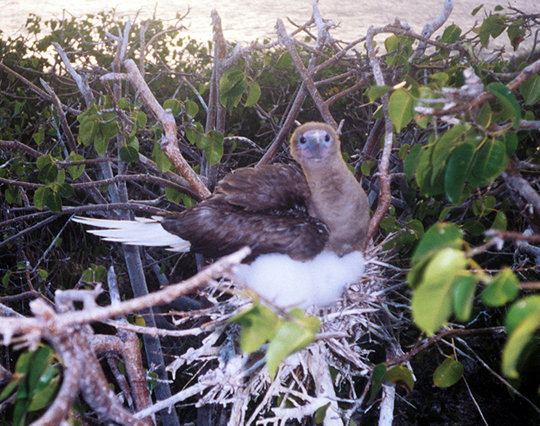 |
|
|
Photo: C. Ruiz-Lebrón |
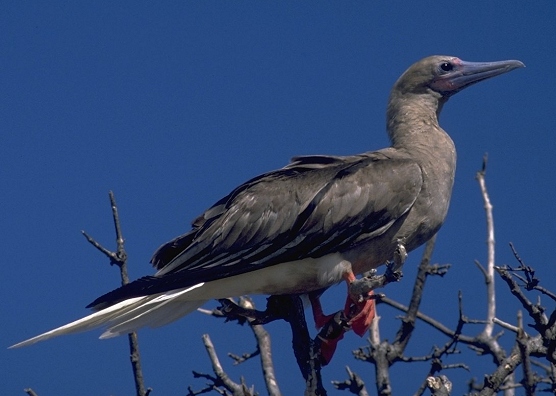 |
|
Photo: J. Hornbuckle
|
 |
|
Photo: J. Hornbuckle
|
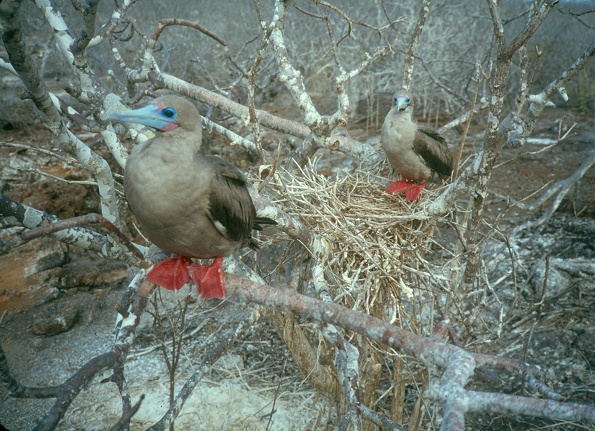 |
|
|
(Galapagos Islands) - Photo: M. Oberle
|
 |
|
|
(Galapagos Islands) - Photo: M. Oberle
|
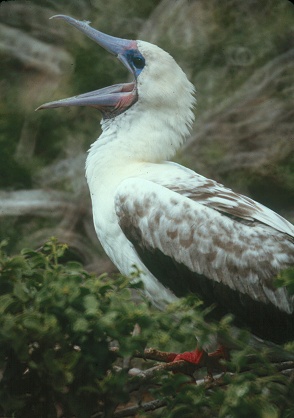 |
|
|
(Galapagos Islands) -Photo: M. Oberle
|
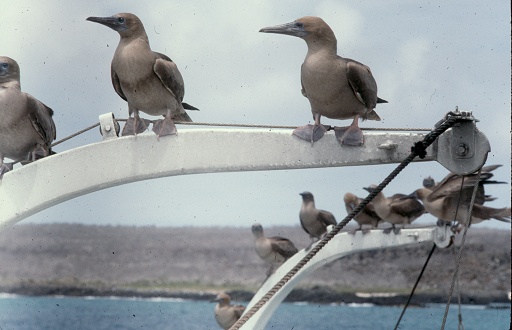 |
|
|
Immatures (Galapagos Islands) -Photo: M. Oberle
|
|
References Bent, A.C. 1922. Life histories of North American petrels and pelicans and their allies. Smithsonian Instit. U.S. National Museum Bull. 121. (Reprinted by Dover Press, 1964). Burger, A. E. and A. D. Lawrence. 2000. Seabird monitoring techniques. Pp. 148-173 in Status and conservation of West Indian seabirds (E. A. Schreiber and D. S. Lee, eds.). Soc. Carib. Ornith., Special Pub. No. 1. Dammann, A.E. and D.W. Nellis. 1992. A natural history atlas to the cays of the U.S. Virgin Islands. Pineapple Press, Sarasota, FL. del Hoyo, J., A. Elliott, and J. Sargatal, eds. 1992. Handbook of Birds of the World, Vol. 1, Ostrich to ducks. Lynx Edicions, Barcelona.
Erdman, D.S. 1967. Seabirds in relation to game fish schools off Puerto Rico and the Virgin Islands. Carib. J. Sci. 7:78-85. Harrison, P. 1983. Seabirds: an identification guide. Houghton Mifflin, Boston. Harrison, P. 1987. A field guide to seabirds of the world. Stephen Greene Press, Lexington, MA. Meier, A. J., R. E. Noble, and H. A. Raffaele. 1989. The birds of Desecheo Island, Puerto Rico, including a new record for Puerto Rican territory. Carib. J. Sci. 25:24-29. Rolle, F. J., H. Heatwole, R. Lewins, and F. Torres. 1964. Faunal notes on Monito Island, Puerto Rico. Carib. J Sci. 4:321-322. Norton, R.L. 1988. The density and relative abundance of Pelecaniformes on the Eastern Puerto Rico Bank in December 1982. Carib. J. Sci. 24:28-31. Raffaele, H.A. 1989. A guide to the birds of Puerto Rico and the Virgin Islands. Princeton. Raffaele, H.A. 1989. Una guía a las aves de Puerto Rico y las Islas Vírgenes. Publishing Resources, Inc., Santurce, PR. Raffaele, H.A., J.W. Wiley, O.H. Garrido, A.R. Keith, and J.I. Raffaele. 1998. Guide to the birds of the West Indies. Princeton. Schreiber, E. A. 2000. Status of Red-footed, Brown and Masked Boobies in the West Indies. Pp. 46-57 in Status and conservation of West Indian seabirds (E. A. Schreiber and D. S. Lee, eds.). Soc. Carib. Ornith., Special Pub. No. 1. Schreiber, E. A., R. W. Schreiber, and G. A. Schenk. 1996. Red-footed Booby (Sula sula). No. 241 in The birds of North America (A. Poole and F. Gill, eds.). Acad. Nat. Sci., Philadelphia, PA, and Am. Ornithol. Union, Washington, D.C. Schreiber, E. A. and D. S. Lee. 2000. West Indian seabirds: a disappearing natural resource. Pp. 1-10 in Status and conservation of West Indian seabirds (E. A. Schreiber and D. S. Lee, eds.). Soc. Carib. Ornith., Special Pub. No. 1. Schreiber, E. A. 2000. Action plan for conservation of West Indian seabirds. Pp. 182-191 in Status and conservation of West Indian seabirds (E. A. Schreiber and D. S. Lee, eds.). Soc. Carib. Ornith., Special Pub. No. 1. Wiley, J. W. 2000. A bibliography of seabirds in the West Indies. Pp. 192-225 in Status and conservation of West Indian seabirds (E. A. Schreiber and D. S. Lee, eds.). Soc. Carib. Ornith., Special Pub. No. 1. Red-footed Booby, Spanish text Next related species in taxonomic order Previous related species in taxonomic order |
|